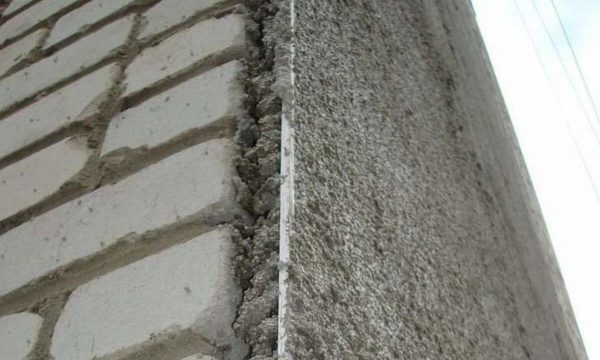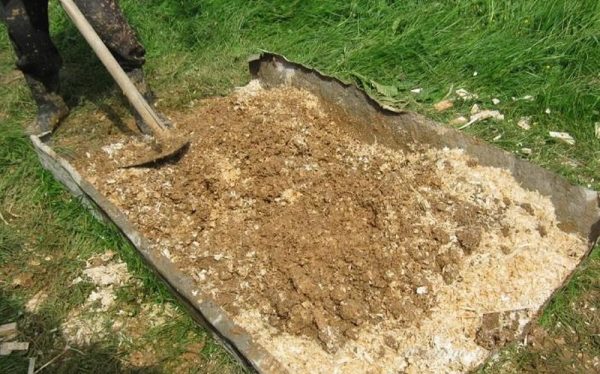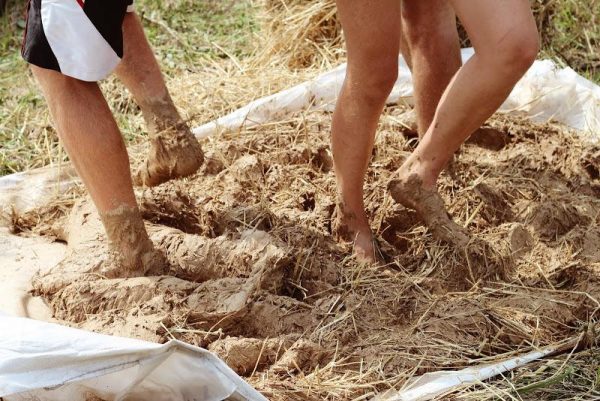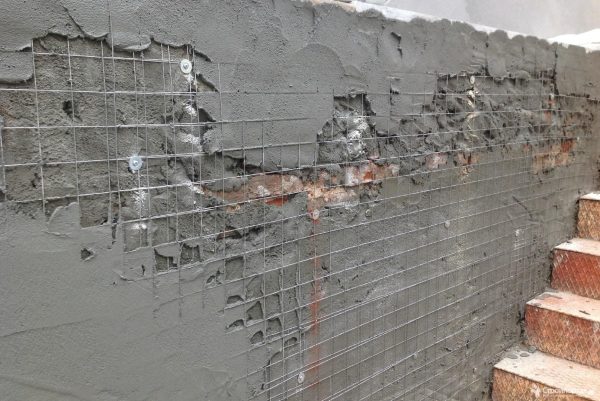Any plaster is intended not only to smooth surfaces, but also to improve sound insulation and reduce thermal conductivity of basic materials. Now on sale there is even the so-called warm plaster, which allows you to create a reliable heat-insulating layer and reduce heat loss from housing.
- What is insulation plaster
- Stucco characteristics
- Advantages and disadvantages
- Where plaster is used for wall insulation
- Internal work
- Outdoor work
- Varieties of plasters
- Plaster with perlite, vermiculite and expanded clay
- Stucco with added foam
- Stucco with polystyrene
- Sawdust-based plaster
- Straw Blend
- Calculation of plaster consumption
- Layer Thickness Calculation
- Application technology
- Preparatory stage
- Essential tool
- Reinforcing layer work
- Mixture preparation
- The principle of applying building materials
- How to make warm plaster with your own hands
- Rating of the best manufacturers by the criterion of "price / quality"
- UMKA® UB 21 TM
- PALADIUM Palaplaster 207
- De Luxe "TEPLOLUX"
- UNIS Teplon
- HAGAst AuBenputzPerlit FS 402
- Knauf grunband

What is insulation plaster
A standard (classical) stucco mixture is usually considered a cement-sand mortar with or without additives. To create a warm plaster, various substances with lower thermal conductivity than cement are used as additional components. Ready-made mortar can be used for decoration of buildings, structures with the aim of warming and increase the comfort of living.

The most popular additives that are suitable for the production of warm plaster are:
- vermiculitis;
- expanded clay;
- volcanic pumice;
- sawdust;
- Styrofoam;
- straw;
- perlite sand.
to contents ↑Some additives cause a significant increase in the cost of plaster, others have excellent performance at a fairly low price. If necessary, it is possible to make heat-insulating plaster yourself without extra costs.
Stucco characteristics
Thanks to warm plasters, it is possible to quickly and efficiently warm the housing and other buildings. Heat-saving plaster allows you to replace a layer of more expensive insulation, reduce the thickness of the brickwork, reduce the total load on the walls. The average technical characteristics of the insulation solutions are as follows:
- specific gravity - 200-300 kg / cubic m (3-4 times lighter than conventional plasters);
- fire safety group - NG-G1;
- high ductility;
- monolithic layer, the absence of delamination and shedding;
- Suitability for surfaces made of brick, stone, concrete, drywall, cellular concrete, etc.
Advantages and disadvantages
Any heat-insulating plaster has the properties of its base (base component), but additionally acquires the quality of the added additives. In many respects, it surpasses conventional stucco mixtures. The main advantages of the material are as follows:
- Light weight and easy styling.The physical parameters of the plaster are such that it fits seamlessly on all types of building surfaces, on vertical, horizontal, inclined surfaces, without causing a significant additional load.
- Excellent insulating ability. A layer of warm plaster of only 5 cm can retain heat in the same way as laying in 2 bricks or polystyrene foam 2-4 cm thick.
- Environmental friendliness. Most plasters do not contain harmful components, do not emit toxic substances (unlike some traditional heaters).
- Fire safety. Many fillers used to create heat-saving plasters are NG - non-combustible (for example, expanded clay, vermiculite, foamed glass). The solution with the addition of expanded polystyrene is low combustible, therefore it is included in another group (G1).
- Universality. Plasters of this type are used for interior and exterior use, suitable for roughing, finishing and even decorative finishes.
- Compatibility. In addition to the fact that the insulating plaster is well suited for all building materials, without exception, it can be combined with other plaster mixes, paint, lime, etc.
- Profitability. The technology of applying the material does not require unnecessary costs, and it itself due to the introduction of inexpensive additives has a lower cost than traditional plasters. Savings when warming the whole building will be significant, especially since the solution can be made with your own hands.
- Improving the microclimate. After plastering the building, it not only optimizes the temperature, but also normalizes the humidity. Some types of warming additives are able to absorb excess moisture, and with a low concentration of steam in the air, on the contrary, give it away.
- Wear resistance. The strength properties of the plaster are at a high level, so it is not subject to mechanical damage, wear and lasts for many years.
Among other advantages, it is worth noting the absence of cold bridges, the high rate of deposition of material on structures, non-susceptibility to destruction from temperature extremes and frost resistance. Disadvantages of insulation plasters are also available:
- in the presence of serious differences and wall defects, it is first necessary to rough draft with a normal solution;
- plaster loses in degree of thermal insulation to many modern heaters, although the latter usually cost an order of magnitude more;
- in harsh climates, home insulation with stucco alone may not be sufficient.
Where plaster is used for wall insulation
In the field of operation of plaster can be divided into facade (materials for outdoor work) and mortars for internal use, although most of them are universal.
Internal work
Heat-insulating plaster is an excellent solution for warming rooms from the inside. It is applied with a non-thick layer (often up to 2.5-5 cm), which will not reduce the usable area, while also preventing heat from leaving the building. Also, the material will help to organize reliable sound insulation, reducing the noise level in the apartment.
When laying plaster on the internal walls, it is important to consider the location of the dew point. At this point, the temperature drops so that moisture from the air begins to condense. If the plane of the dew point is inside the main wall, the latter will gradually collapse. It is important that water vapor from the air does not become liquid and does not freeze. This will not happen only with excessive heating of the house or with high-quality insulation of the external walls together with the internal ones.

Insulating plaster is suitable for other internal works:
- decoration of door and window openings, slopes;
- sealing shells, cracks, indentations;
- elimination of laminations of simple plaster;
- facing curvilinear architectural structures, niches, domes.
Outdoor work
Warm plaster is ideal for the facade. Usually its layer does not exceed 5 cm, in rare cases it is brought up to 10 cm, but it is applied in several stages and only on the reinforcing mesh. The dried material is coated with protective compounds, for example, paint, to reduce the risk of moisture soaking from the atmosphere.
In outdoor works, insulating plaster can be used for finishing plinths, sealing various cracks, cladding floors, ceilings in unheated rooms. Sewer risers, water supply systems are insulated with material. Plaster will reduce heat loss in garages, auxiliary buildings, other structures, while it can be used as the main or auxiliary (additional) insulating layer.

Stucco is excellent for finishing hard-to-reach areas in which the use of conventional heaters is not possible or violates the design of architectural solutions. It is recommended to apply it in the areas adjacent to materials with completely different technical characteristics (for example, where the wooden surface borders on the stucco layer).
to contents ↑Varieties of plasters
Warm finishing mixtures can be grouped in this way:
- Materials for the formation of a preliminary insulation layer for finishing decorative coatings. They act as auxiliary thermal insulation and resemble aerated concrete and ceramic blocks in terms of heat-saving properties.
- Building mixtures with high thermal insulation properties and increased strength. They are used as the main insulation layer, including the finishing layer.
Thermal insulation materials are divided according to the basic composition and additional components. Most of the mixtures are prepared on the basis of cement, but some plasters additionally contain components that make the material foam and resemble foam concrete. Foamed plasters have increased insulation abilities, but are porous, therefore, require the application of protective coatings.
to contents ↑Plaster with perlite, vermiculite and expanded clay
Vermiculite is a hydromica with a layered structure, a popular mineral filler, which is produced by heat treatment of rocks. It is great for outdoor work, especially for facade decoration. When heated, vermiculite swells, fills with air, therefore materials based on it turn out to be very light. The mineral has antiseptic properties, is not afraid of frost and temperature extremes.
Perlite (obsidian hydroxide) is created by solidification of volcanic lava in contact with water. Due to the high porosity (40%), the granules are also used for the manufacture of warm plasters. Both perlite and vesiculitis strongly absorb water and odors and require mandatory finishing. Expanded clay is made during the firing of fusible clay varieties, which are then turned into crumbs. This material does not conduct heat well and is great for facade plasters.
to contents ↑Stucco with added foam
Granular foam glass is another high-quality filler for warm plaster. It is made of ordinary glass after cleaning, grinding to dust, combining with carbon and melting in a furnace at high temperature. The finished composition is very foaming and, after solidification, turns into porous grains.

Glass-based insulation plaster is recommended for both indoor and outdoor use. It has many advantages:
- allows steam, but does not absorb water;
- very strong, resistant to stress;
- easy to fit;
- reliably retains heat;
- has a low weight.
Stucco with polystyrene
Expanded polystyrene is a type of expanded polystyrene with improved technical characteristics. The material is widely used in construction and repair, including in the form of crumbs. Ultralight grains, coupled with cement and lime, make it possible to produce a high-quality mortar suitable for:
- facades;
- plastering window, door slopes;
- insulation and sound insulation of internal walls;
- cladding structures for water supply, sewage systems;
- pouring floor screed.

to contents ↑Expanded polystyrene does not absorb water, does not deteriorate from mold, does not serve as a habitat for microbes. Its disadvantage is that even in the absence of strong flammability, it still emits toxic substances during combustion.
Sawdust-based plaster
Sawdust has been used to warm a person’s housing for many years - before they were sprinkled with rubble, mixed with clay and coated the walls. The thermal conductivity coefficient of sawdust is lower than that of wood, so they retain heat even better in the house (no worse than polystyrene foam).

To create a warm plaster, sifted sawdust is introduced into the cement-sand mass, often clay or shredded paper, gypsum, and lime are additionally added. Such material is suitable for internal work, applied to the base of brick, wood, concrete. The dried layer will have excellent heat, sound insulating properties and will maintain a favorable microclimate in the room.
to contents ↑Straw Blend
Usually warming plasters made of clay and straw are used to make a rough layer on shingles. Straw not only reduces the thermal conductivity of the mass, but also reinforces the coating, which subsequently does not delaminate, does not crack. The plaster layer is breathable, it is able to absorb moisture from the air when it is surplus and to give it when there is a lack. Such plaster is the cheapest and easy to apply with your own hands.

Calculation of plaster consumption
When buying a dry construction mixture, you can easily find its consumption on the packaging, because the manufacturer always indicates this indicator in kg / sq. m. If you decide to make the solution yourself, you will have to take into account average consumption rates depending on the size of the layer:
- with a plaster thickness of 2.5 cm, 10-14 kg of weight per 1 sq. m;
- with a layer thickness of 5 cm, about 18-25 kg per 1 sq. m
to contents ↑Usually, an improvement in heat and noise insulation is already observed when the plaster layer is 0.5 cm thick. Of course, this is not enough for effective insulation, therefore this indicator should also be selected more accurately.
Layer Thickness Calculation
Most manufacturers advise applying a layer of mortar with insulation properties of sufficient thickness - 2.5-5 cm. This will allow the plaster to fully realize its heat-insulating abilities and create an additional protective layer. The choice of formation dimensions should also depend on the thickness of the walls themselves. For example, to actually reduce heat loss in a house with walls 50 cm thick, you need to apply a plaster layer of 8-10 cm. For regions with extreme climate, individual calculations are required, as well as for non-standard base materials.
to contents ↑Application technology
The technique of plastering walls with an insulating mortar practically does not differ from the classical one. It is important only to monitor compliance with the optimum temperature during operation, otherwise the adhesion of the material to the base may be impaired. The ideal option is when the temperatures of the air and the treated surface are approximately the same, and the plaster mixture itself is still slightly warmer.
Preparatory stage
Before the start of the main work, surface preparation is carried out. All protruding elements are removed from the wall - protruding reinforcement, influxes of old mortar, cut protruding sections of brick or concrete. Peeling off the coating is also cleaned, sand is removed from the panel joints, the remains of the insulating material.Stains of fat, oil are wiped off, any impurities are washed. Cracks are closed, if necessary, then they are pre-embroidered. In order to remove dust and enhance adhesion, a primer is applied, it is allowed to dry for 12-24 hours.
to contents ↑Essential tool
To dilute dry plaster or mix the mortar yourself, prepare a container and a construction mixer, or a drill with a special nozzle. The plaster itself is applied by machine or manually. In the first case, hopper buckets or other devices are used, in the second - spatulas of different sizes (including angular, front, gear), rule and grater (trowel).

Reinforcing layer work
If a single-layer application of the solution is planned, then reinforcement is not required, because warm plaster has a small specific gravity. In such a situation, you can plaster the walls without a grid, using beacons, leveling the building mixture between them.
The application of reinforcing structures is considered necessary when the plaster layer is planned to be thicker than 3-4 cm, or the wall has significant differences and has previously been treated with conventional plaster. Use a fiberglass mesh with cells less than 5 * 5 mm, which will not allow the coating to crack. The procedure will be as follows:
- applying the first layer of warm plaster;
- overlaying mesh 2 hours after plastering;
- heating the mesh with a notched trowel;
- applying a new layer of solution 2 days after reinforcement.

Mixture preparation
Before mixing the mixture, carefully read the instructions, which are always accurate and quite detailed. It is important to take a strictly specified amount of water, otherwise the material will not find the desired consistency. Some plasters have a short initial setting period after adding water, therefore it is better to work in an accelerated mode. First, water is poured into the container, then the dry mixture is added in portions and mixed with a mixer until a homogeneous, even mass is obtained. After 5 minutes, the plaster is kneaded again and proceed to the main stage.

The principle of applying building materials
Heat-insulating plaster is applied in layers, and the thickness of each layer should not exceed 2-2.5 cm. The mass is laid on the wall with a metal spatula, leveled with a trowel or rule with movements from left to right and up, while removing excess. Each subsequent layer is applied 4 hours after the previous leveling.
Then the beacons are removed from the walls (if they were installed), the cavities are covered with the same material. Grasped, but not completely dried up surface is wiped with a construction grater, having moistened it a little in more liquid plaster. After the final setting, a primer is applied, and then decorative plaster or paint. Also, if desired, decorate the walls or other structures with tiles, stone, stone chips.
to contents ↑
How to make warm plaster with your own hands
A major advantage of warm plaster over other types of finishing materials is the ability to make it yourself, while significantly saving. When mixing the mixture, the solid components are first joined together and only then added to water until a solution of the required consistency is obtained.
Popular "recipes" for the manufacture of insulation plasters are as follows:
- Mix 1 part cement and sand, add 4 parts perlite. Mix the composition well.
- To 1 part of cement add 4 parts of expanded vermiculite or foam glass. When diluted with water for every 10 l, introduce 50 g of PVA glue.
to contents ↑After mixing the dry mixture and water, if desired, you can add a little sawdust, paper to the solution (if you plan to use it for internal work).
Rating of the best manufacturers by the criterion of "price / quality"
In the list of manufacturers, products that are truly trustworthy, there are both rather expensive plasters and high-quality compounds with a more affordable cost.
UMKA® UB 21 TM
This building mixture as a filler contains special silicon (ceramic) balls with a porous structure. Despite the low price, it perfectly reduces the thermal conductivity of the main material of the walls, saves heat, and also provides reliable sound insulation. The tool is suitable for all types of stone substrates, can be used indoors and outdoors. The characteristics of the stucco mixture are as follows:
- possible layer thickness - 10-100 mm;
- the amount of water per 1 kg of finished mass - 0.53-0.58 l;
- consumption per 1 square. m with a layer thickness of 10 mm - 3.5-4 kg;
- the life of the solution is 60 minutes;
- thermal conductivity coefficient - 0.065.
to contents ↑Umka is so strong that it is easily held on the surface even without reinforcement, because the total weight of the dried layer is quite small. Also on sale there are other mixes of the brand - UMKA UB-212 (thin-layer, for hollow bricks and gas silicate) and UMKA UF-2 (decorative, for finishing with additional heat-insulating properties).
PALADIUM Palaplaster 207
As a filler, this sand-cement mortar contains foamed glass - a strong, modern and reliable component in the form of small grains. It is porous, but does not absorb moisture, suitable for all types of finishing work. After applying the plaster, you don’t have to worry about fire safety: the plaster layer will be completely non-combustible. This building mixture will provide a high degree of noise and heat insulation for many years.

De Luxe "TEPLOLUX"
Plaster of this brand is used for finishing concrete foundations, as well as for insulation of structures and buildings made of foam concrete. The adhesion of the agent to the indicated bases will be the highest, which is associated with the inclusion of fine granules of foam concrete, which provides heat-insulating properties. Technical characteristics of the material are as follows:
- color - gray;
- filler fraction - up to 3 mm;
- consumption per 1 square. m with a layer thickness of 10 mm - 4.5-5 kg;
- recommended layer thickness - 4 cm;
- adhesion strength - 0.4 MPa;
- compressive strength - 2.5 MPa;
- the life of the solution is 240 minutes;
- complete drying time of the coating - 14 days;
- thermal conductivity coefficient - 0.065;
- frost resistance - 25 cycles.
UNIS Teplon
Under the brand name “Teplon”, 4 types of gypsum-based plasters are produced, while 3 of them are used only in dry rooms, and one is moisture resistant, but does not position itself as heat-saving. The differences between the Teplon gypsum plasters are in color (white or gray), as well as in the introduction of special additives to increase the life of the solution (from 50 minutes for Teplon White and Teplon Gray to 90 minutes for Teplon MN) .

As a filler, the materials contain perlite granules, which give them the properties of a conventional insulation and lighten the weight of the plaster layer. Unfortunately, any Teplon coating is hygroscopic and can only be used in rooms with normal and reduced humidity. The thermal conductivity of the mixtures is 0.23.
to contents ↑HAGAst AuBenputzPerlit FS 402
Such a plaster mix in the base contains cement, and perlite acts as a filler in it. The material is used for foam concrete, aerated concrete, suitable for interior use, can be applied in combination with ceramic blocks. The plaster is flexible, impact resistant, environmentally friendly.
to contents ↑Knauf grunband
The building mixture from Knauf is widely used for insulation of facades, basements, rooms with high humidity, as it additionally provides reliable waterproofing. It contains polystyrene foam granules, as well as special moisture-resistant additives that reduce the dispersion of the layer and prevent its impregnation with wet vapors.The material has decorative properties and can serve as a finish.
Warm plaster is an excellent solution to reduce heat loss in housing. It is best to use it in combination with other heaters, because in this case the finished thermal insulation will be as reliable and durable as possible!















